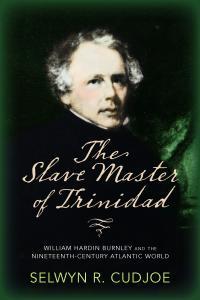Andrew Haswell Green
By Dr Selwyn R. Cudjoe
November 26, 2018
I am always astonished when I realize how unaware we are about certain aspects of our history. I had completed my book on William Hardin Burnley, the biggest slave owner in Trinidad, when I received a fascinating note from a reader.
My name is Henry Albert. I am a retired accountant and working on a project with the goal of becoming a docent for Preservation Worcester, a local Worcester, MA nonprofit.
The topic includes Andrew Haswell Green, a local man who became well known in 19th century New York City. Supposedly, Green's family knew William Burnley of Trinidad.
This information became more significant when I learned who Green was and his association with Burnley. Green was prominent in New York City. He was responsible for bringing the five boroughs-Manhattan, Staten Island, Brooklyn, Bronx, and Queens-together into one municipality in 1898. Before that, they were all separate entities. Green was called "The Father of Greater New York" for pulling off this important feat.
Green was born in Worcester, Massachusetts, on October 6, 1820. In 1835 he moved to New York City to seek his fortune. He met Burnley there in February 1841. Burnley was happy to meet a young white man who was willing to work as an overseer on his plantation. He recruited him immediately. By November Green had arrived in Trinidad to take up his appointment.
Green went straight to Burnley's sugar estate in Orange Grove, Tacarigua. While he was there, "he lived in a shed that was eight-feet-by-eight-feet off the main house. The shack had no 'roof,' just shingles placed across the eaves, frequently exposing Green to the weather" (Michael Rubbinaccio, New York's Father Is Murdered, 2012).
At Orange Grove, Green met Burnley Hume, Burnley's nephew, the son of Joseph Hume, the British parliamentarian, and his sister Maria, who had also come to Trinidad to learn the tricks of the trade a year earlier. Maria retained the Burnley family's name through her son.
At Orange Grove, Green "became acquainted with the cultivation of the sugar cane, the manufacture of sugar, molasses, etc., but seeing how crude were the methods used, tried without success to introduced improved processes" (A. H Green Papers, New York Public Library).
Green noted that "the Negroes of this land and on the estate are a peculiar people. Once in a state of abject slavery, they now have so great an idea of themselves that they carry their freedom of speech to the most vulgar and obscene impudence."
Black people in Trinidad were seeking to chart a new future at that time. Green surmised: "There must be much more advancement among this people in moral education and in general knowledge before a regular and industrious population can be established, and this will take much more time. That the proprietors of the estates unitedly have the laborers in their own hands at present is certain, but as the people advance, ambition will be excited, each man will strive for a competency in the way in which it can be most easily acquired, and this will give a population not immediately dependent on the planters, and regular and steady in their occupations."
Green also had harsh words for the planters who he felt were "extremely short sighted" and who were concerned mostly with their immediate self-interest. He began to hold religious classes to improve the condition of the laborers. They were not interested and refused to attend.
Green lasted only ten months in Trinidad. By September 1842 he headed back to New York City on a British ship called The Humming Bird. It was a fit way to bid farewell to the island. Green kept a journal of his experiences on what transpired at Orange Grove.
Green achieved many important things after he left Trinidad. He became the chairman of the New York City Board of Education and the controller of the city's finances. He also toppled the Boss of Tammany Hall, William Tweed, and addressed the corruption that Tweed was known for.
Green was also a close friend of Samuel Tilden who ran for the United States presidency in 1876. Like Hillary Clinton, he won the popular vote (he received 4,288,546 as opposed to Rutherford Hayes's 4,034,311) but lost the electoral vote. Hayes won 185 Electoral College votes as opposed to Tilden's 184 votes.
After Tilden's defeat, Green played an important role in the civic life of New York City. Rubbinaccio says that if it were not for his efforts "New Yorkers would not have the American Museum of Natural History, the Bronx Zoo, the New York Public Library, nor the Metropolitan Museum of Art to enjoy and trumpet as items that are quintessentially 'New York.'"
While he was in Trinidad Green "learned large large-scale administration and undoubtedly was responsible for numbers, volume and budgetary tasks. That and his devotion to service and his religion are all very early building-blocks for the foundational principles and skills upon which he lived the rest of his life" (New York's Father Is Murdered).
Green's brief stay in Trinidad had little impact upon the island. However, we can claim a part in his development. It also demonstrates Burnley's international reach and why he was such an important personality in Trinidad's development.
Professor Cudjoe's email address is scudjoe@wellesley.edu. He can be reached @ProfessorCudjoe.
Share your views here...

The Slave Master of Trinidad by Dr. Selwyn R. Cudjoe
|

